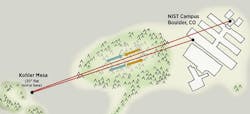NIST uses laser frequency combs to wirelessly transport ultraprecise time signals
Boulder, CO--National Institute of Standards and Technology (NIST) researchers have transferred ultraprecise time signals through open air by bouncing eye-safe laser pulses off a mirror on a hillside with unprecedented precision equivalent to the "ticking" of the world's best next-generation atomic clocks. Described in Nature Photonics (http://www.nature.com/nphoton/journal/vaop/ncurrent/full/nphoton.2013.69.html), the demonstration shows how next-generation atomic clocks at different locations could be linked wirelessly to improve geodesy (altitude mapping), distribution of time and frequency information, satellite navigation, radar arrays and other applications. Clock signals of this type have previously been transferred by fiber-optic cable, but a wireless channel (http://www.laserfocusworld.com/articles/2010/11/photonics-applied-free-space-communications-sophisticated-optical-system-extend-reach-of-free-space-communications.html) offers greater flexibility and the eventual possibility of transfer to and from satellites.
The stability of the transferred infrared signal (http://www.laserfocusworld.com/articles/2013/04/Secure-quantum-code-by-aircraft-LMU.html) matched that of NIST's best experimental atomic clock, which operates at optical frequencies. Infrared light is very close to the frequencies used by these clocks, and both are much higher than the microwave frequencies in conventional atomic clocks currently used as national time standards. Operating frequency is one of the most important factors in the precision of optical atomic clocks, which have the potential to provide a 100-fold improvement in the accuracy of future time standards. But the signals need to be distributed with minimal loss of precision and accuracy.
The signal transfer demonstration was performed outdoors over a two-way wireless link using two laser frequency combs (http://www.laserfocusworld.com/articles/print/volume-48/issue-01/features/frequency-combs-make-their-way-to-the-masses.html). A frequency comb generates a steady stream of ultrashort optical pulses with a spacing that can be synchronized perfectly with the "ticks" of an optical atomic clock. In the experiment, the two combs were synchronized to the same stable optical cavity, which serves as a stand-in for an optical atomic clock. Each comb pulse was sent from one of two locations on NIST's campus in Boulder, CO, reflected off a mirror on a mesa behind the campus, and returned to the other site, traveling a total distance of 2 km.
Researchers measured travel times for pulses traveling in opposite directions between the two sites. The cumulative timing differences and frequency instabilities were infinitesimal, just one million-billionths of a second per hour, a performance level sufficient for transferring optical clock signals.
The transfer technique overcomes typical wireless signal problems such as turbulence in the atmosphere--the phenomenon that makes images shimmer when it's very hot outside. Because turbulence affects both directions equally, it can be cancelled out. The transfer technique can also withstand signal losses due to temporary obstruction of the light path. The method should be able to operate at much longer distances, possibly even over future ground-to-satellite optical communication links as an added timing channel, researchers say.
The combs potentially could be made portable, and the low-power infrared light is safe for eyes. The research is funded in part by the Defense Advanced Research Projects Agency.
SOURCE: NIST; http://www.nist.gov/pml/div686/time-043013.cfm#

Gail Overton | Senior Editor (2004-2020)
Gail has more than 30 years of engineering, marketing, product management, and editorial experience in the photonics and optical communications industry. Before joining the staff at Laser Focus World in 2004, she held many product management and product marketing roles in the fiber-optics industry, most notably at Hughes (El Segundo, CA), GTE Labs (Waltham, MA), Corning (Corning, NY), Photon Kinetics (Beaverton, OR), and Newport Corporation (Irvine, CA). During her marketing career, Gail published articles in WDM Solutions and Sensors magazine and traveled internationally to conduct product and sales training. Gail received her BS degree in physics, with an emphasis in optics, from San Diego State University in San Diego, CA in May 1986.
